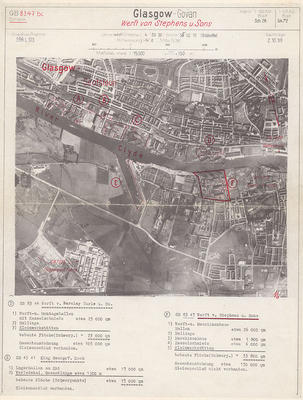
An aerial view of Clyde shipyards and docks taken by a Luftwaffe reconnaissance aircraft in October 1939, shortly after Britain went to war with Germany. Alexander Stephen & Sons's shipyard is marked for special attention, as are the shipyard of Barclay, Curle & Co, King George V Dock, and, at the bottom left hand corner, the Rolls-Royce aircraft engine works on the Hillington Industrial Estate.
Glasgow did not suffer such intense air raids during 1940 as did many large English cities. Any complacency was dispelled by intense bombing raids on the nights of 13-14 and 14-15 March 1941, when an estimated 250 German bombers attacked Clydeside targets and caused extensive damage and heavy casualties.
The raids became popularly known as the "Clydebank Blitz" because of the scale of devastation in the town. However, more people were killed in Glasgow where the damage was spread over a wider area. In the worst single incident, 110 people died when a landmine exploded between a tram and a tenement in Nelson Street. Tenements were destroyed in Kilmun Street, with eighty-three deaths. Eighty workers were killed in a direct hit on their shelter at Yarrow's Shipyard. In Peel Street, Partick, fifty people died when their tenements were bombed.
Reference: Glasgow City Archives, TD308/1
Reproduced with the permission of Glasgow City Council, Libraries Information and Learning
Keywords:
aerial views, air raids, aircraft engines, Alexander Stephen & Sons, Barclay, Curle & Co, blitz, bombing, casualties, Clydebank Blitz, Clydeholm Shipyard, docks, Hillington Industrial Estate, King George V Dock, Linthouse Shipyard, Luftwaffe, reconnaissance, River Clyde, Rolls-Royce, Second World War, shipyards, Yarrow's Shipyard
You have 0 images in your photo album.